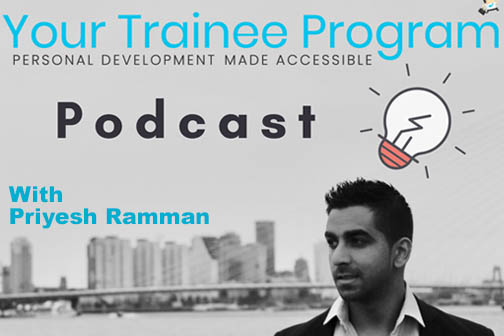Recently I was asked to talk about voice, speaking and communication with Priyesh Ramman for his podcast, Your Trainee Program.
Priyesh represents, to me, the exact type of client I like to work with: someone eager, ambitious, openminded, self-aware, and willing to put in the time and effort it takes to change one’s speaking voice for the better.
Priyesh believes that it’s not only knowledge that leads to power, but that human interaction is the key to getting ahead, finding out what your true path is, being more effective at what you do. Priyesh, then, was already more amenable to working on the how as the what.
How means that you have to say the right thing, of course—that’s the what—but what really matters is the how: you have to say it well. How you say something is often more important than what you say. Studies have shown that what listeners really take away from a conversation or a speech is based 80 percent on one’s voice tone and 20 percent on the actual words.
Call: 505-466-6500
Voice Power Studios Blog
Joan, the marketing VP of a national telecommunications company called me recently, asking me to help her “spiff up” her company’s sales people. As Joan put it, “The reps are not closing the sales, the morale is low, and we’re turning over people every couple of months. Your website says, “You too can use your voice to increase your company sales and your reps’ commissions. If you can do that, I will hire you to train 250 salespeople.”
I told her I could. She hired me. And this is how I did it and what happened.
The first thing I told Joan was basically what Laura Lake, now a senior manager of integrated marketing for T-Mobile, stated in a piece she’d done for The Balance Small Business. “We are all born with our voices, but they can, in fact, be trained.”
So, yes, we use what we are born with, but we can also modify and train what we have. We can make ourselves better, more effective communicators. And it all starts with our voices.
And in sales, voices are pretty much everything. (Not many people have had success selling something with semaphore or charades.) However, as good as many salespeople are, most don’t realize how much more they could sell if they paid more attention to how they are saying it. As was the case with Joan and her sales team, they didn’t even realize their very own voices were sabotaging their relationships with their customers.
As the famous American song says, “Make someone happy and you will be happy too!” But making someone else happy just with the sound of your voice? Really? Yes, really and truly. When you convey happiness to others through the sound of your speaking voice it’s amazing how quickly that sound affects them. Your happy voice can give the momentary gift of hope to others and it is a powerful way to communicate confidence and inspire others to be confident as well.
“Voice has a lot to do with how we interact with each other,” Maraliz Campos, a certified sound practitioner and meditation instructor, tells Bustle. “One of the most immediate ways to influence the vagus nerve—the longest nerve of the autonomic nervous system that has both sympathetic and parasympathetic functions—is through auditory stimulation. Therefore, the sounds we hear have a direct impact on our stress levels causing us to gravitate to sounds and voices that are pleasurable.”
2020 brought substantial changes in many directions — personal and professional. But the ever-resilient business world adapted quickly. One major change, which seems to have stuck, is working from home. And a large part of that virtual workday involves communicating with coworkers and clients via business video-conferencing platforms such as Zoom and Google Meet.
Unless you are an A-list actor, though, you likely feel a bit self-conscious about being on video. You are hardly alone. A 2016 study by Highfive and Zobgy Analytics found that 59 percent of people feel more self-aware when on-camera than they do in their off-camera life at the office.
These days everyone is selling, negotiating, facilitating, mediating, and giving presentations on live video. Few things are more annoying than not being able to see or hear someone in a video conference. But those small images and having everyone on mute with their cameras turned off make it difficult to assess audience response or to create audience interaction.
2020 brought substantial changes in many directions — personal and professional. The ever resilient business world adapted quickly. One major change is continuing to work from home and communicating over recorded business video-conferencing platforms.
Unless you are an A-list actor, you likely feel a bit self-conscious about being on video. A 2016 study by Highfive and Zobgy Analytics found that 59 percent of people feel more self-aware when on-camera than they do in their off-camera life at the office.
These days everyone is selling, negotiating, facilitating, mediating and giving presentations on live video. Few things are more annoying than not being able to see or hear someone in a video conference. Small images and having everyone on mute with their cameras turned off make it difficult to assess audience response or to create audience interaction.





